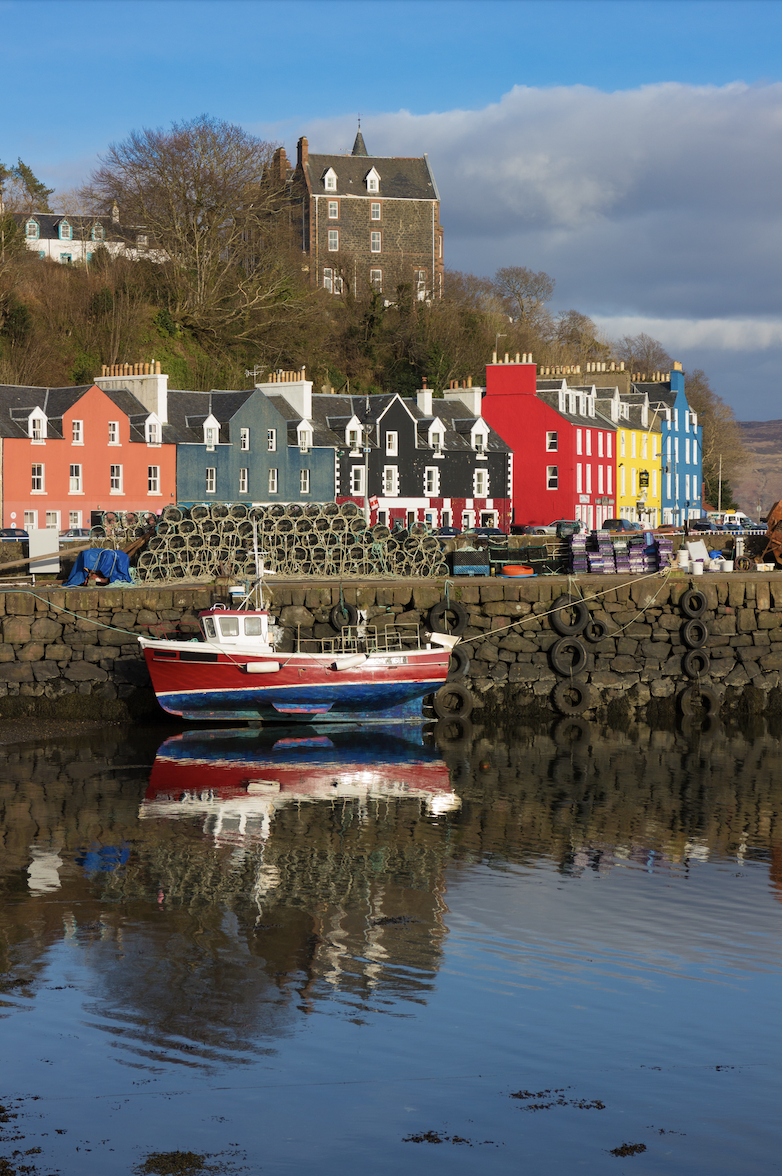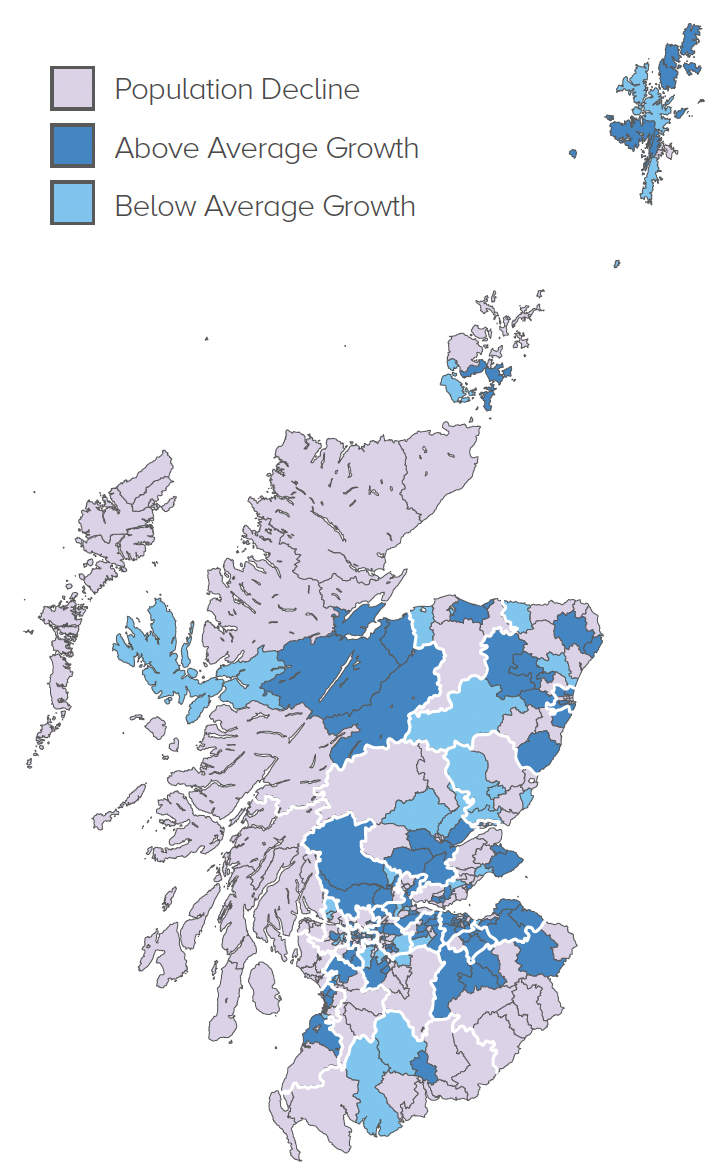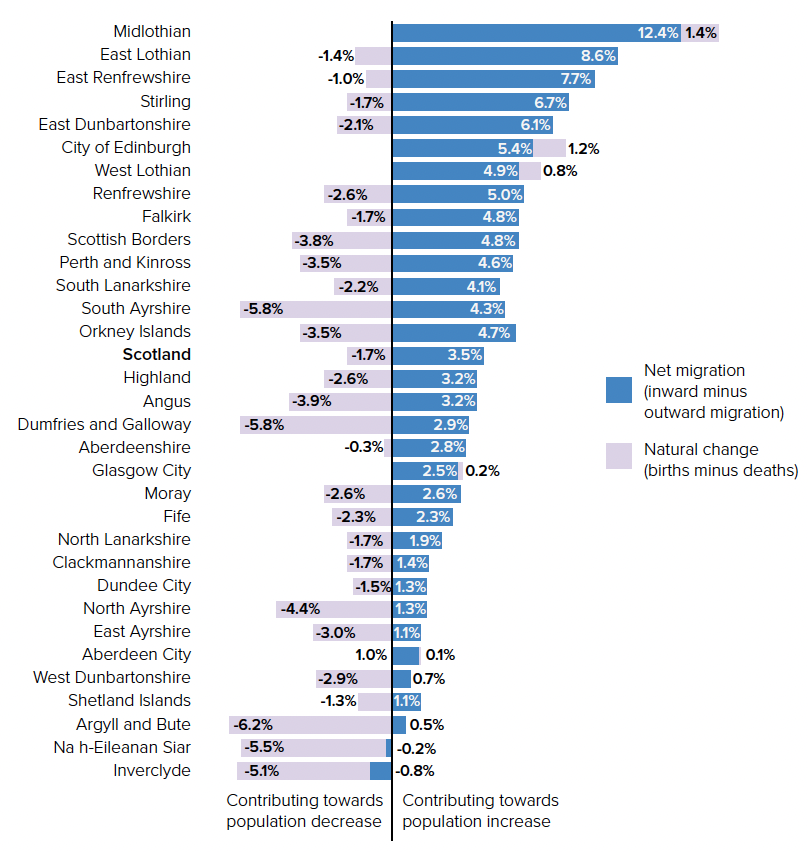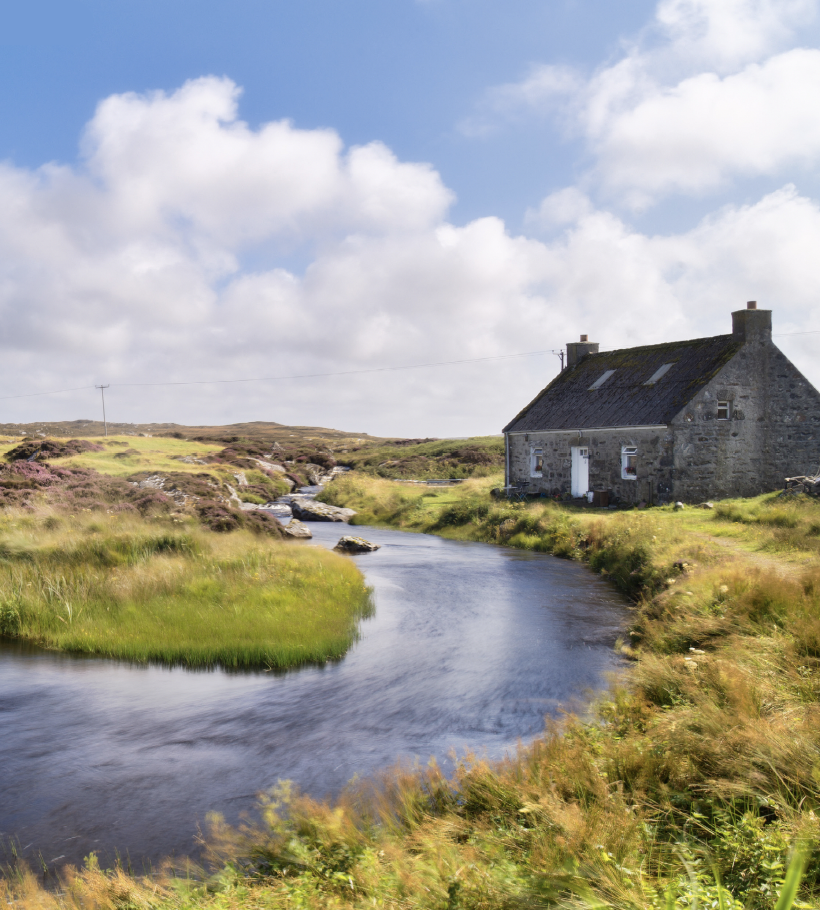Supporting and enabling sustainable communities: action plan to address depopulation
This Action Plan newly establishes a strategic policy position for Scottish Government around addressing depopulation and maps a range of new and existing supportive activity being undertaken across Scottish Government and by local and regional delivery partners.
03 Context
3.1 National context
National Records of Scotland updated national-level population projections in January 2023 to reflect revised international migration figures and assumptions about future international migration. These projections emphasise Scotland’s fundamentally different (and more challenging) demographic position in comparison to the rest of the UK, as framed within Scotland’s Population Strategy. Among the key points include:
1. The population of Scotland is projected to continue increasing until around mid-2033, peaking at 5.53 million. It is then projected to fall by 0.6% to 5.49 million by mid-2045. The projections show Scotland’s population falling below the mid-2020 baseline by around 2050.
2. The projected population change for Scotland is lower than the figure for the UK as a whole. The population of the UK is projected to grow by 8.0% to mid-2045. If these projections are realised, Scotland’s share of the UK population would fall from 8.1% in mid-2020 to 7.6% by mid-2045.[1]
3. Scotland’s falling overall population size will coincide with an increasingly ageing population structure. The number of people aged 65 and over is projected to grow by nearly a third by mid-2045. The number of children is projected to fall by nearly a fifth. The population aged 16-64 is projected to fall slightly (-3%).
4. More people are projected to move to Scotland than leave each year. However, there are projected to be more deaths than births each year, and the gap between births and deaths is projected to widen. Over time, this is projected to outweigh the growth from migration.
5. Crucially, the potential impact of a considerable loss of in-migration to Scotland following the ending of freedom of movement is not accounted for in these projections, and we are already seeing the impact of the ending of freedom of movement on labour shortages in key sectors of our economy and public services. It is therefore possible these projections may still be providing a more optimistic interpretation of future migration trends than can be expected should current UK immigration policy continue.
3.2 Local context
While the above projections are undoubtedly useful in framing the national level challenge which we face with regard to our future population structure, the impact of a changing population is not being felt equally across Scotland – with many of our rural and island areas and those on the west coast facing particular challenges.
The most recent National Records of Scotland sub-national population projections[2] demonstrate a varied picture with regards to future population change across Scotland.
A majority of council areas (18 out of 32) are projected to increase in population by mid-2028. 14 councils are projected to decline (more than the 8 in the previous projections).
Most population growth is projected to be in the central belt and urban areas, while most examples of population decline have been observed in, and are projected to mainly be in, the West of Scotland.. However, depopulation as a phenomenon typically occurs at a smaller, local level, and population projections covering entire local authorities, as set out below, can mask trends occurring within smaller geographies. While local authority-level projections are helpful in pointing towards likely future trends, this Action Plan sets out more local level interventions where population decline is occurring, in order to have a targeted impact in the communities where it is needed most.

Projected population change, 2018 to 2030
The following Scotland-wide map was provided by the Improvement Service and harnesses National Records of Scotland data around population projections to show projected population change at sub-local authority level from 2018 to 2030. Twenty-six local authorities below are broken down by multi-member wards. The remaining six (Argyll and Bute, East Renfrewshire, Highland, North Ayrshire, South Ayrshire and South Lanarkshire) requested that the Information Service used different sub-council areas, such as Housing Market Areas, Community Planning Partnership Localities, Neighbourhoods and Community Areas.
The map below details those same projections across the central belt, demonstrating the variability in projected outcomes at a local level. This further emphasises the need to embed a targeted and place-based approach to delivering the strategic approach set out within this Action Plan.


In most councils, population increase is the result of migration, with more people arriving than leaving. Inverclyde and Na h-Eileanan Siar are the only councils projected to have more people leaving than arriving. In most councils, there are projected to be more deaths than births, contributing to population decline.

Following the publication in September 2023 of national and local authority-level data from Scotland’s Census 2022, in Spring 2024 we expect to see released small area data, down to neighbourhood level. This will be crucial in informing our approach to addressing depopulation in a targeted way and enable us to review our approach with the most up-to-date and granular data available. This small area data will also enable regional and local partners to identify where they may wish to prioritise efforts to address depopulation, if they so choose.
Action
We will harness sub-local authority data from Scotland’s Census 2022, when it becomes available in 2024, to review this plan to further inform the development and delivery of targeted, community-level interventions.
Population Strategy context
Underpinning the national approach which the Scottish Government is taking to address our population challenges, and harness new opportunities, is the delivery of Scotland’s first national Population Strategy, published in March 2021.
The ‘Population Balance’ chapter within the Strategy set out the importance of population change at the local and regional level, with the national position clearly masking divergent outcomes occurring at a local level. It is in response to this strand of the Population Strategy that this Action Plan has been developed, putting firm action in place which will enable us to achieve our aim of a sustainable distribution of our population, in a way that works for places and enables local ambitions for change.
Within the Strategy, we are clear that a wide range of interconnected issues drive depopulation, where it occurs, and that there is not a single solution which would work everywhere. We state the importance of the sense of place which people gain from living in an area – this Action Plan will set out how we intend to support and enable this, for the benefit of communities, their economies, and their public services. This is the starting point from which we aim to address this issue at a national level.
Verity House Agreement
Since the Scottish Government announced development of this Action Plan, the New Deal with Local Government has been agreed between COSLA and the Scottish Government. This sets out our vision for a more collaborative approach to delivering our shared priorities for the people of Scotland and underpins what we hope to achieve through this Action Plan, and how we hope to achieve it.
All three shared priorities contained within the agreement – tackling poverty, just transition to net zero, and sustainable public services – are relevant to a strategic agenda focused on addressing depopulation. In order to maximise economic opportunity evident across Scotland and not just in select locations, and to realise net zero across a range of sectors current facing labour shortages, it is crucial that conditions are created to enable people to live and work in areas currently experiencing depopulation. However, the priority to ‘deliver sustainable person-centred public services recognising the fiscal challenges, ageing demography and opportunities to innovate’ is most clearly aligned with what we will seek to achieve with this Action Plan.
Actions within this document will, where relevant, be designed and delivered entirely within the spirit of the Verity House Agreement, namely in line with the maxim of ‘local by default, national by agreement’. Through applying this principle, the Scottish Government will seek to act as a facilitator and enabler for local government, economies and communities to address challenges in a manner which best meets local needs. To do this in the context of work to address depopulation, the Scottish Government will consult and collaborate with Local Government, for example harnessing existing mechanisms such as the SG/COSLA Population Roundtable (which brings together the Scottish Government and COSLA with all 32 local authorities to discuss population matters) and the Population Programme Board (which includes senior leadership from the Scottish Government, COSLA and the enterprise agencies), and ensure that in every relevant case, local, place-focused leadership is enabled to inform shared priorities and objectives to be realised.
National Islands Plan
As required by the Islands (Scotland) Act 2018, and after an ambitious consultation exercise, the National Islands Plan was published in December 2019. It provides a framework for action to meaningfully improve outcomes for island communities. It sets out 13 Strategic Objectives and over 130 commitments, which must be delivered over the five-year lifetime of the Plan.

The Population Strategic Objective in the Plan outlines commitments that aim to address population decline by ensuring a healthy, balanced population profile in islands. However, it is fair to say that the commitments across the entirety of the National Islands Plan all contribute to this objective. Depopulation was the top priority issue identified by respondents to the National Islands Plan consultation and this is why, within the National Islands Plan, we committed to “developing an action plan to support the repopulation of rural and island communities”.
The National Islands Plan recognises that, in the view of island residents, decision makers are remote from them. Furthermore, islands and island communities in Scotland are not only resilient, but also innovative. Whether it is in the field of community-based solutions in estate management, energy or digital connectivity, health delivery, in the arts, in culture or in language, island communities are often paving the way for ideas and solutions that can then be exported to the mainland. The concepts of remoteness and peripherality, how they are applied to places, and how the use of such language may itself affect perceptions and depopulation is an important consideration in our approach to supporting sustainable, thriving communities.
Action
As required by the Act, the National Islands Plan will be fully reviewed in 2023-2024 to make sure it is fit for purpose. This will help us to ensure our islands policy and support continues to prioritise the actions which will best improve outcomes for communities. If the analysis of the review determines it appropriate, the Scottish Government will develop a revised National Islands Plan in 2024-2025 that will help to ensure that we continue to deliver our ambitions and to realise our vision for thriving, sustainable and successful island communities.
National Planning Framework 4
We know from speaking to stakeholders and communities that there is a need for the planning system to be an enabler for us to deliver a more balanced population. National Planning Framework 4 (NPF4) replaces National Planning Framework 3 (2014) and Scottish Planning Policy (2014) and represents a package of planning policies to guide us to the place we want Scotland to be in 2045, and was developed with a strong understanding of spatial variation in demography. We also know that, through this system, every effort must be made to ensure that unintended consequences for outcomes in relation to sustainable populations are minimised. NPF4 does this by being required by law to contribute to the following six outcomes:
1. Meeting the housing needs of people living in Scotland including, in particular the housing needs for older people and disabled people
2. Improving the health and wellbeing of people living in Scotland
3. Increasing the population of rural areas of Scotland
4. Improving equality and eliminating discrimination
5. Meeting any targets relating to the reduction of emissions of greenhouse gases
6. Securing positive effects for biodiversity
NPF4 also recognises that, in areas in southern Scotland such as Dumfries and Galloway and the Scottish Borders, Regional Spatial Strategies and Local Development Plans should “increase the population by improving local liveability, creating a low carbon network of towns and supporting sustainable rural development”.
In areas such as parts of: the Highlands; Argyll and Bute; and Moray, Regional Spatial Strategies and Local Development Plans “should maintain and help to grow the population by taking a positive approach to rural development that strengthens networks of communities”.
Local Place Plans
The Planning (Scotland) Act 2019 introduces local place plans. Linked to the NPF and local development plans, they will provide the opportunity for communities to influence the development of their neighbourhoods in a way which builds on community empowerment across Scotland.
Local Place Plans are to be taken into account by the planning authority in the preparation of Local Development Plans, and can provide an effective new method for rural and island communities to engage and shape their local priorities to deliver the benefits of local living.
Provisions on the preparation, submission and registration of Local Place Plans came into force in January 2022, with resources to support communities in preparing Local Place Plans are available through the ourplace.scot website.
Rural Delivery Plan
The Scottish Government is clear that there is already good work ongoing across the country, much of which will feature within this Action Plan. In supporting this work, and delivering new commitments, we will proactively target investment and support where we think the biggest gain can be realised, with an underlying principle that outcomes are driven by the aspirations and ambitions of communities. In the First Minister’s policy prospectus, published in Spring 2023, a commitment was made to publish a Rural Delivery Plan, showing how all parts of the Scottish Government are delivering for rural Scotland. This will include areas such as agriculture, land reform, marine, islands, transport, housing, social justice, population, digital connectivity, economic development, skills, health and social care, and the environment. Development of the Plan is being overseen by a Ministerial Working Group, jointly chaired by the Deputy First Minister and Cabinet Secretary for Rural Affairs, Land Reform and Islands. The delivery model and policy areas covered by this Action Plan will align closely to, inform, and be informed by, the wider work to develop and implement the Rural Delivery Plan.
Contact
Email: population@gov.scot
There is a problem
Thanks for your feedback